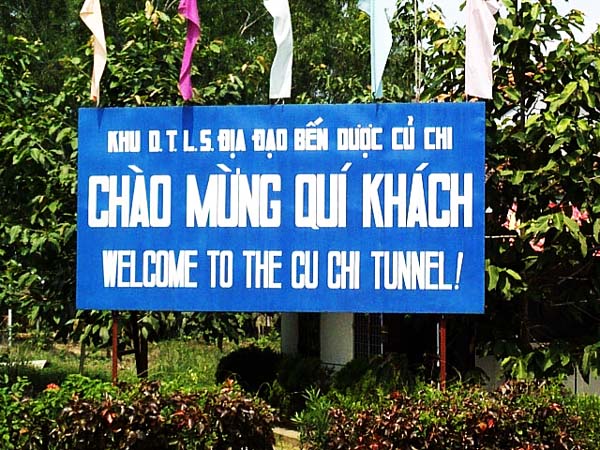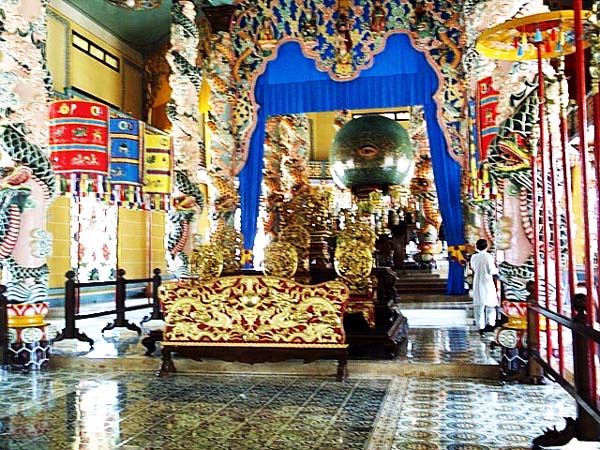The Return Trip 2000 – 7
Day Five - Cu Chi and Tay Ninh
Picture this.
We five Manchus are sitting in the restaurant of the Hoa Binh Hotel in Tay Ninh. It seems we are the only guests in the state run establishment when in walk three western looking couples who seat themselves at a table at the other end of the room. Curiosity eventually takes over and compels us to approach the new arrivals.
"Pardon us," we say. "But would we be right to think you're not from these parts?"
"Ah, but we are," responded a tall, distinguished gent with a curly shock of brown hair. "I served here 30 some years ago with the 25th Division, actually with Delta Company 4th Battalion 9th Infantry they were called the Manchus."
You can imagine how it went from there. The gent with the curly hair was Kelly Albrecht, Artillery Forward Observer with Delta Company from October of 67 until he was wounded in January of 68. He and his wife were in Tay Ninh with two other couples making their tour of the old AO. What a small, small world. Kelly now knows about the reunion we're having in DC next August and said he would love to come. He seemed even more interested when we told him that Hector Colon was coming. Let's hope he makes it.
A most interesting day. It began with the two hour drive from Saigon to Cu Chi. The old base camp is off limits as it is a Vietnamese Army Base these days. With that crimp in our style the only logical stop was the Cu Chi Tunnels. It is a showplace for the tunnels the VC began building in the 1940's and it is clear the government has placed much emphasis on developing the site as a major tourist attraction. There were a large number of Vietnamese touring the site while we were there. A handful of visitors of other nationalities were also there during our stop.
The tour focuses on the ingenuity of the designers of the tunnels and illustrates just how complex some of them must have been. The examples they make available to visitors has a distinct Disneyesque quality to them which is probably fair enough since the real McCoy would have made it quite a chore for western sized hips to waddle through. As it was, the underground passages were more challenging than some of us (okay I confess, read that me) were willing to accept. After one tight squeeze through a 10 meter long hole I'd had enough. Not so for our intrepid Fellow Travelers. Larry Ward was in his element. There wasn't a hole he didn't duck into with relish.
Part of the program requires visitors to sit down and watch a presentation extolling the virtues of the "triumphant patriotic forces." Included in the scratchy black and white film are repeated references to the "VC heroes who prevailed in their fight against the American aggressors." The star was clearly a 14 year old girl who was said to have single handedly killed 138 Americans. The film said she and any VC who distinguished him or herself in battle were recognized by the VC as an "American Killer Hero."
What followed this over-the-top presentation was an interesting description of the Cu Chi Tunnels complex. Most interesting of all was the explanation that, contrary to what I had been led to believe by all I had read, even the VC don't claim to have had any tunnels under the American base. Their map shows the extensive tunnel network in an area north and slightly east of the 25th Division base camp. In fact, the visitors center is some 22 kilometers away from it. There may be more to the story but it was a head scratcher.
The tour of the tunnels ends at a firing range where visitors can fire a variety of American weapons. We passed on that as we wanted to keep our schedule and make it to Tay Ninh with enough time to visit the Cao Dai temple and Nui Ba Dinh. We made it and everything was spectacular.
The temple is extraordinary. The religion is based on the idea that there have been 3 connections to God. The first was Moses. The second Jesus Christ and the third a triumvirate of 1) a Vietnamese Buddhist monk (sorry but I can't remember his name) 2) the French writer Victor Hugo and the Chinese nationalist 3) Sun Yat Sen. The complicated theology is an appropriate fit for the intricate and ornate temple itself. Larry Ward had visited the temple during his tour and had said it was really something. It was and we burned a lot of film on it.
From there it was off to Nui Ba Dinh, the Black Virgin Mountain. Any American who operated near Tay Ninh knows the mountain. Rising alone in the midst of miles and miles of flat rice paddies made it "the" landmark. It is one of the most memorable images of our tours of duty. It was such a surprise to see it today. It no longer cast an ominous shadow across the landscape. Since the war's end the Vietnamese have built a cable car system that takes visitors about a third of the way up the mountain. There you stop to visit a Pagoda. Yep a Pagoda built more than a hundred years ago to honor the local girl who came to be known as the Black Lady. She evidently had reached such a state of enlightenment that she because a female monk. Her place in history was secured when she died very young. It seems those who came to the mountain to mourn her claimed to have experienced miraculous cures. The pagoda has been recently restored and is truly beautiful. Not the largest pagoda we've visited but then again it was the only one we've seen built on the side of a very steep mountain. That it was done more than a century ago is impressive. I had no idea it was there. I doubt I was alone in that.
Corn Drying
Hien and Larry james
Larry Ward
Rick Everett
The days here in Saigon and the Delta seemed to be pretty different from 30 plus years ago. Maybe a lot of that was due to the explosive growth of the population that has taken place. But once you get away from the cities and the wall-to-wall houses that line the main highways, the small villages are still the same. Well, still the same except nearly all of them now have a TV antenna sprouting out of the roof. Welcome to the MTV generation.
As you can imagine with all this change it is very difficult to find old base camps or specific locations. Time did not stand still. The Vietnamese government has built a damn near Nui Ba Dinh that has flooded much of the AO north and east of the mountain. Willy tells me that means Fire Support Base Gold is now under water. Where damns haven't changed the land scape urban sprawl has. The area around the Hoc Mon bridge, for example, has changed dramatically. There are no real hootches anymore. Most of the structures are brick and mortar homes with tile roofs and floors. Those coming back to visit will be frustrated in their attempts to find their old haunts by the inevitable changes that more than 30 years bring.
After our overnight in Tay Ninh we drove back to Saigon via Dau Tieng the home of the 2nd Brigade of the 25th during the war. Curiously when our guide Hien told us we were in Dau Tieng we didn't understand. Turns out that we have been misprouncing the name of the place all these years. Dau Tieng is not DOW TEE-YANG but YOW TYIN. Hmmm. Live and learn.
From there it was back down Highway 13 to Saigon with a stop in Song Be province to visit an orphanage.
See ya then.

Cu Chi Tunnels

Western Sized

Underground

VC

Cu Chi Tunnels complex

Cao Dai Temple

Spectacular

Extraordinary

Ornate

Nui Ba Dinh

Cable Car

Third

Corn Drying

Hien and Larry James

Larry Ward

Rick Everett

